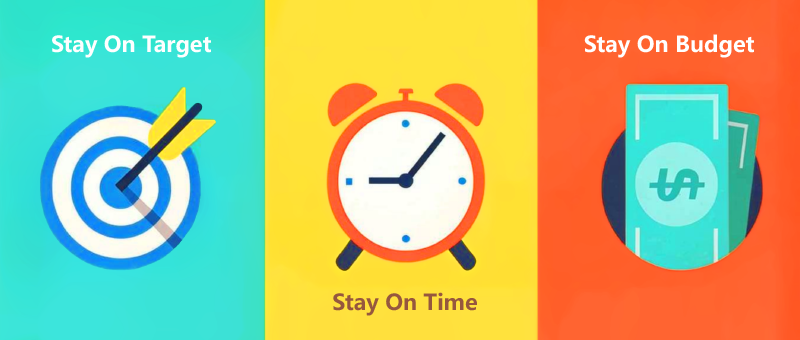
-
The Connected View: Seamless Project Planning and Real-Time Execution with 8Manage PPM

The only time project planning and execution can be separated is when you need to determine the target of your project. Otherwise, they at all times should be connected. Project execution would enhance the project plan and project planning and re-planning would make project execution better organized and more effective. The worst scenario is that a person makes a project plan and throws it to another person to execute. A person can make the requirements and throw them to another person to plan and execute so that at least project planning and execution aren’t architected for separation.
For project planning and execution software, rich functionality is a plus but the most important thing is that it can present the connected view of project planning and execution. The connected view of project planning and execution is the real-time view of their cause-and-effect relationships. Even for a 10-people 10-week project, it can have tens of activities and dependencies and hundreds of resource allocation and utilization. The information is too complicated for a human brain to process and see the cause-and-effective relationships between project planning and execution in real-time. Many project managers aren’t aware of the level of complexity because they seldom find adequate real-time tools that can truly help them with resource allocation and utilization and they can’t really do that with spreadsheets or spreadsheet-like PM tools.
Using 8Manage PPM, a project plan can be approved and re-approved after it is changed. The approval and re-approval processes will automatically create a nonerasable baseline of the project plan which can be emailed to stakeholders in the physical world as your latest commitment and story. But your true story in the computer continues to change as your project continues to be executed. Some project managers are uncomfortable to see that the real story is different from the baselined story (commitment). We all laugh at ostriches putting their heads in the sand and we don’t want to do it ourselves, do we? Accurately understanding where you are is the best way for you to take action to meet your commitment. If your target is achievable and you are a competent project manager, the only logical reason that you can’t meet your commitment that is you know the true story too late.
Project Planning
8Manage PPM provides you with the following workflows for project planning:
Create Activities
Start by creating a work breakdown structure (WBS) that decomposes your entire project into smaller actionable activities and sub-activities. For example, a product marketing campaign can be broken down into buyer persona research, choosing promotional channels, creating marketing collateral, and going live. The manager then defines the work for each activity, like buyer persona research, with details such as how to gather demographics, when to conduct surveys, and where to collate the data. This results in a streamlined process for the project.
Set up Timeline
Set start and finish dates for each activity. No matter how small or big the activity, one has to set realistic deadline expectations for each activity. Suppose you are an IT manager with multiple service activities. You have to set the start and finish dates of each activity in your project management tool, so you can convey to users when their issues will be solved.
Document Dependencies
Some activities and sub-activities will remain dependent on others. For example, in a web design project, the copywriter cannot create a copy without the wireframes. Likewise, the designer needs guidelines from the brand manager for creating these wireframes. 8Manage PPM can help you track these changes and automatically schedule the dependencies if one of the activities in the chain gets delayed.
Create Milestones
A milestone is a culmination of multiple activities and sub-activities which marks an important achievement in the project. A milestone must have at least one deliverable which can be checked by one or more stakeholders. Let’s say your sales team has to generate $120,000 for the quarter. You can divide this target into 3 milestones of $40,000 each, and whenever the sales team reaches a milestone, you know you are getting closer to the end goal.
Appoint Responsible Persons
Once you have your activities, dependencies, and milestones set up, you need to start assigning a responsible person to each activity or sub-activity to execute the project. You can start appointing responsible persons by inviting the selected team members to the project and give them a brief and explain their roles and record the responsible person’s appointment information in 8Manage PPM. You can then work with the top-level activity responsible persons to further break down the top level activities into sub-activities and repeat the same process to appoint responsible persons for sub-activities or this can be done in a bottom-up manner and let each top-level activity responsible person do his or her own work breakdown and appointment of a responsible person to each sub-activity.
Allocate Resources
This is the most detailed part of project planning and it is extremely hard to do a good job without a central up-to-date resource database. Most project managers know their schedules and deliverables well, but not their resource allocation and utilization well. They blame the problem on the facts of life that not all resources are reporting to them, but that is only a small part of the reason. The biggest reason is that the literature existed for resource management is far less adequate than the literature existed for time and cost management. In other words, people learn resource management far less adequately than they learn time and cost management from the environment. But, unfortunately, if resources aren’t managed well, time and cost won’t be managed well either.
8Manage PPM allows you and the activity responsible persons to find resources based on skills, location and availability and allocate them if there is no conflict. If a resource conflict exists, 8Manage PPM will help you resolve it.
Project Execution
8Manage PPM provides you with the following workflows for project execution:
Track Progress
Tracking the progress of the activities in your project is critical. It determines if the project will be completed by the deadline or not. If you were an operation manager of a service center, where executing daily activities is critical for your business, you have to ensure that your team logs in on time, completes service requests and updates the number of service requests on time. Failing to check on these things will result in a catastrophe. Likewise, every project will have daily activities, and checking on these daily activities for timely execution is critical.
Weekly Reporting
Weekly reports, especially through real-time dashboards, will give you perfect knowledge of the progress of each activity and the project as a whole. Weekly reports would also keep the management and clients updated on the project’s progress. This helps avoid surprises.
Identify Bottlenecks
A lot of time you would find your colleagues stuck on a particular activity. Maybe they need necessary information or guidance on how to execute the activity. This is where conversing within the activity compared to in-person or via email is more effective. As communication is always in the context of the activity. This also prevents miscommunication.
Communicate Regularly
The prerequisite of effective project communication is a single source of truth (SSOT) which is the real-time aggregating of up-to-date scope, time, cost quality, resource, communication and risk data that can affect each other from the lowest level activities to the top activities and to the project. Once you set up 8Manage PPM and obtain SSOT which would provide insights into real-time issues, you could hold regular remote or face-to-face meetings with your team to discuss achievements, problems and resolutions. You could also take this opportunity to boost the morale of the team and keep them motivated.
Converse in Real-time
If your team gets stuck in a problem, they should be able to resolve it instantly through real-time conversation and collaboration. For instance, if a team member is facing a challenge he can immediately tag a colleague for help within the activity itself. 8Manage PPM offers both an instant communication mechanism like chat and the asynchronous communication mechanism -- activity comments which will be automatically converted to email by the system to send to the activity stakeholders.
Engage with External Stakeholders
External stakeholders, such as your clients and engagement partners, need to know what’s happening with the project on a regular basis. Here’s what you can do with 8Manage PPM:
Give them external user logins to access project data -- Let’s say you are managing a software product development project. You can invite your clients and engagement partners in 8Manage PPM and give them the appropriate access rights to the functionality and information. For example, if your stakeholders are worried about the product development progress, a product burn-down chart which illustrates the product goals achieved so far and the work left will reassure your stakeholders that the project is proceeding as planned.
Manage Changes Effectively
Scope creep is part of every project. There’s no escaping from that. Your stakeholders are bound to come up with additional requests that will definitely affect your scheduled activities. You can use 8Manage PPM to record change requests and understand the changes and change impact. By doing so, you would know where to fit the new request within the project lifecycle or you have to say “no”. Change management doesn’t do magic but arms you with impact and realistic timeline information so that you and your stakeholders can make proper tradeoffs together.































































































